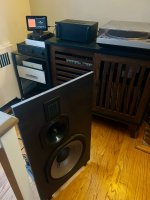That's fantastic! That's a nice 10th Anniversary Edition there. The OPA1656 is indeed a good opamp.Sitting here listening and enjoying the silky smooth mids with this amp!
I have adapted my favorite OPA1656 as input buffer. Other than that no changes.
Tom
I'm sure the Modulus-86 could be completely redesigned to be current output, but that's not on my radar right now. The Modulus-86 will drive a 5.8-6.8 Ω load just fine.Hi Tom, do you think the Modulus 86 can be modified to work as current drive amplifier for AMT driver, which impedance is rather constant at 5.8 to 6.8 Ohms from 1kHz-40kHz?
Tom
The secret sauce in the Modulus-686 is the LME49724. Without it I'd have to design a differential driver which requires 2-3 opamps. That's about $100 worth of OPA627 and about $160 worth if I replace all opamps/diff amps with OPA627. That's a lot of money and I'm not convinced the reward is big enough.
Tom
Tom
I did this build a couple years ago…
https://www.diyaudio.com/community/threads/modulus-86-build-thread.267802/post-7078876
…a Neurochrome Modulus-86 3.0 six-channel amp to drive Linkwitz LX521 top baffles.
I recently replaced the lower and upper midrange modules with tomchr's Tenth Anniversary Edition update. I plan to address a couple of issues installing those new modules in my own amp on Tom's Neurochrome forum. Here I'll just say that they seemed to carry the "improved focus and palpable realism" I mentioned in my original post an additional step forward in the same direction, and it was worth doing.
https://www.diyaudio.com/community/threads/modulus-86-build-thread.267802/post-7078876
…a Neurochrome Modulus-86 3.0 six-channel amp to drive Linkwitz LX521 top baffles.
I recently replaced the lower and upper midrange modules with tomchr's Tenth Anniversary Edition update. I plan to address a couple of issues installing those new modules in my own amp on Tom's Neurochrome forum. Here I'll just say that they seemed to carry the "improved focus and palpable realism" I mentioned in my original post an additional step forward in the same direction, and it was worth doing.
I'm happy to hear that you're happy with the results. Thanks for sharing your listening impressions.
Tom
Tom
After a long and not intended break I am back my project. I assembled everything on a plank for a test. On one channel the dc offset does not stabilize. I connected a test speaker to it, and there are a series of loud pops within a few seconds of power on. The frequency of pops increase. Supply is ok, connections verified a number of times. Any ideas where to even begin debugging?
Flip the boards over and check for bad solder joints. I find it helpful to either examine the board with a loupe or to take a clear picture of the board and zoom in. A good solder joint looks like a concave cone that drapes the pin and that's circular when viewed from the top.
Feel free to email me a picture of the bottom of the board if you need my help. Just make sure the picture is in focus. Add @neurochrome.com to my user ID here for my email address.
Tom
Feel free to email me a picture of the bottom of the board if you need my help. Just make sure the picture is in focus. Add @neurochrome.com to my user ID here for my email address.
Tom
With some kind and relentless support from @tomchr, I have figured it out, I installed one of the opamps in reverse. Fortunalety the opamp survived, and it's working now. The sound seems very good, the first thing I noticed is the tight bass. I don't remember hearing this much bass from these speakers.

Using small wood screws with non-threaded standoffs intended for M3 machine screws works too. I've done that quite a bit in the past.
Tom
Tom
Taking a hiatus from my regularly-scheduled program of "Class A Amp of the Month," I put my Modulus 86 in the main system this morning. It's The Little Engine That Could.  Sounds great. Thanks again for sharing your great products and expertise with the DIY world, Tom.
Sounds great. Thanks again for sharing your great products and expertise with the DIY world, Tom.
 Sounds great. Thanks again for sharing your great products and expertise with the DIY world, Tom.
Sounds great. Thanks again for sharing your great products and expertise with the DIY world, Tom.Attachments
Paralleling 2 parrallel86 boards?
I have a couple of the old boards and some of the chips and other parts to build them. I need to power a 4ohm transducer for the .1 duties of a surround sound system. I was wondering how hard/easy it would be to use these boards together as the mono low channel?
I have a couple of the old boards and some of the chips and other parts to build them. I need to power a 4ohm transducer for the .1 duties of a surround sound system. I was wondering how hard/easy it would be to use these boards together as the mono low channel?
I wouldn't. The Parallel-86 can deliver 125 W into 4 Ω without issues, so there's no need to parallel it further. It's basically the predecessor to the Modulus-286.
Tom
Tom
ok, thanks! I also have a couple of 286 modules? Any chance to parallel those further? I think 125 watts is plenty though for one transducer.
I'm curious why you would want to parallel two Modulus-286. You'd get better performance with a 2 Ω load, but for the 4-8 Ω commonly used in hifi paralleling multiple Modulus-286 won't make a lick of difference.
Have a look here: https://neurochrome.com/pages/output-power
Tom
Have a look here: https://neurochrome.com/pages/output-power
Tom
- Home
- Amplifiers
- Chip Amps
- Modulus-86 build thread
